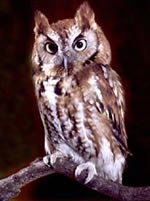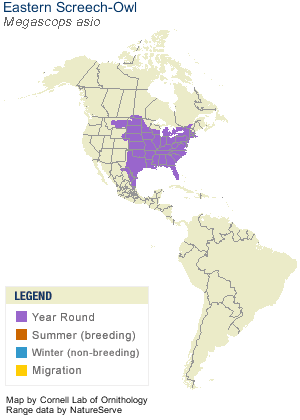
 Eastern Screech Owl
Eastern Screech Owl
Megascops asio
Education birds representing this species: Ayasha (Alumni: Otis) - species also represented in Exhibit Room
Page at "All About Birds" web site at the Cornell Lab of Ornithology
Interesting Facts:
- Often mates for life
- Does not actually screech
- All owls have feathers on their feet and it seems they serve many purposes - see June 5th update for details.
Physical Dimensions:
- wing span ~20 - 24 inches
- weight ~4 - 8 ounces (females slightly larger)
Prey
- insects
- earthworms
- songbirds
- rodents
- crayfish
Hunting Techniques:
- sit and wait
Range:
- Eastern half of North America
- Found in habitats with trees (including suburban areas)
- Minimal migration, if any

Color:
- no sexual dimorphism (when males and females differ in coloring). Sexual dimorphism is unusual in raptors.
- Screech owls have red and gray morphs (Otis is gray morph, Ayasha is red morph). Red is found more in pine forests, gray is found more in deciduous forest. Red is genetically dominant, but scientists believe gray somehow provides an advantage to survival and reproduction - that's why there are still so many of them. This advantage may be directly related to its gray coloring, OR gray coloring is linked to another genetically-based quality that is the actual advantage - scientists are working on that question. Screech owls are in the process of becoming two seperate species - eventually in the distant future the red morph will likely be one species, and the gray another. For now, different colored mates are the exception, not the rule, so usually an entire clutch will be the same color as both their parents. When red and gray DO mate, the offspring can be the intermediate brown phase. See FAQs for a suggested answer for questions related to this.
Reproduction:
- Mates for life
- Does not build a nest - lays eggs on surface in unlined cavitities of hollow trees, sometimes abandoned holes of flickers/woodpeckers.
- "Builds" nest in February-April
4 - 5 eggs
26-30 days of incubation
Fledged at 28-30 days
Independent of parents at 8-10 weeks
Conservation:
- No conservation issues - widespread and common